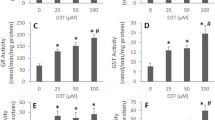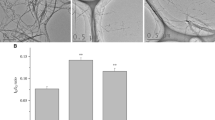Abstract
Cerium oxide nanoparticles, also known as nanoceria, possess antioxidative and anti-inflammatory activities in animal models of inflammatory disorders, such as sepsis. However, it remains unclear how nanoceria affect cellular superoxide fluxes in macrophages, a critical type of cells involved in inflammatory disorders. Using human ML-1 cell-derived macrophages, we showed that nanoceria at 1–100 μg/ml potently reduced superoxide flux from the mitochondrial electron transport chain (METC) in a concentration-dependent manner. The inhibitory effects of nanoceria were also shown in succinate-driven mitochondria isolated from the macrophages. Furthermore, nanoceria markedly mitigated the total intracellular superoxide flux in the macrophages. These data suggest that nanoceria could readily cross the plasma membrane and enter the mitochondrial compartment, reducing intracellular superoxide fluxes in unstimulated macrophages. In macrophages undergoing respiratory burst, nanoceria also strongly reduced superoxide flux from the activated macrophage plasma membrane NADPH oxidase (NOX) in a concentration-dependent manner. Token together, the results of the present study demonstrate that nanoceria can effectively diminish superoxide fluxes from both METC and NOX in human macrophages, which may have important implications for nanoceria-mediated protection against inflammatory disease processes.






Similar content being viewed by others
Data availability
The datasets generated during and/or analyzed during the current study are available from the corresponding author on reasonable request.
Abbreviations
- CDCL:
-
Coelenterazine hcp-derived chemiluminescence
- DEPMPO:
-
5-(Diethoxyphosphoryl)-5-methyl-1-pyrroline-N-oxide
- EPR:
-
Electron paramagnetic resonance
- FBS:
-
Fetal bovine serum
- FCCP:
-
Carbonyl cyanide 4-(trifluoromethoxy) phenylhydrazone
- LDCL:
-
Lucigenin-derived chemiluminescence
- METC:
-
Mitochondrial electron transport chain
- NOX:
-
NADPH oxidase
- PBS:
-
Phosphate-buffered saline
- ROS:
-
Reactive oxygen species
- SOD:
-
Superoxide dismutase
- TPA:
-
12-O-Tetradecanoylphorbol 13-acetate
References
Casals E, Zeng M, Parra-Robert M, Fernandez-Varo G, Morales-Ruiz M, Jimenez W, Puntes V, Casals G (2020) Cerium oxide nanoparticles: advances in biodistribution, toxicity, and preclinical exploration. Small 16:e1907322. https://doi.org/10.1002/smll.201907322
Niu J, Azfer A, Rogers LM, Wang X, Kolattukudy PE (2007) Cardioprotective effects of cerium oxide nanoparticles in a transgenic murine model of cardiomyopathy. Cardiovasc Res 73:549–559. https://doi.org/10.1016/j.cardiores.2006.11.031
Selvaraj V, Manne ND, Arvapalli R, Rice KM, Nandyala G, Fankenhanel E, Blough ER (2015) Effect of cerium oxide nanoparticles on sepsis induced mortality and NF-kappaB signaling in cultured macrophages. Nanomedicine (Lond) 10:1275–1288. https://doi.org/10.2217/nnm.14.205
Hegazy MA, Maklad HM, Samy DM, Abdelmonsif DA, El Sabaa BM, Elnozahy FY (2017) Cerium oxide nanoparticles could ameliorate behavioral and neurochemical impairments in 6-hydroxydopamine induced Parkinson’s disease in rats. Neurochem Int 108:361–371. https://doi.org/10.1016/j.neuint.2017.05.011
Heckert EG, Karakoti AS, Seal S, Self WT (2008) The role of cerium redox state in the SOD mimetic activity of nanoceria. Biomaterials 29:2705–2709. https://doi.org/10.1016/j.biomaterials.2008.03.014
Wang Z, Shen X, Gao X, Zhao Y (2019) Simultaneous enzyme mimicking and chemical reduction mechanisms for nanoceria as a bio-antioxidant: a catalytic model bridging computations and experiments for nanozymes. Nanoscale 11:13289–13299. https://doi.org/10.1039/c9nr03473k
Codo AC, Davanzo GG, Monteiro LB, de Souza GF, Muraro SP, Virgilio-da-Silva JV, Prodonoff JS, Carregari VC, de Biagi Junior CAO, Crunfli F, Jimenez Restrepo JL, Vendramini PH, Reis-de-Oliveira G, Bispo Dos Santos K, Toledo-Teixeira DA, Parise PL, Martini MC, Marques RE, Carmo HR, Borin A, Coimbra LD, Boldrini VO, Brunetti NS, Vieira AS, Mansour E, Ulaf RG, Bernardes AF, Nunes TA, Ribeiro LC, Palma AC, Agrela MV, Moretti ML, Sposito AC, Pereira FB, Velloso LA, Vinolo MAR, Damasio A, Proenca-Modena JL, Carvalho RF, Mori MA, Martins-de-Souza D, Nakaya HI, Farias AS, Moraes-Vieira PM (2020) Elevated glucose levels favor SARS-CoV-2 infection and monocyte response through a HIF-1alpha/glycolysis-dependent axis. Cell Metab. https://doi.org/10.1016/j.cmet.2020.07.007
Korsvik C, Patil S, Seal S, Self WT (2007) Superoxide dismutase mimetic properties exhibited by vacancy engineered ceria nanoparticles. Chem Commun (Camb). https://doi.org/10.1039/b615134e
Pirmohamed T, Dowding JM, Singh S, Wasserman B, Heckert E, Karakoti AS, King JE, Seal S, Self WT (2010) Nanoceria exhibit redox state-dependent catalase mimetic activity. Chem Commun (Camb) 46:2736–2738. https://doi.org/10.1039/b922024k
Nolan M, Parker SC, Watson GW (2006) CeO2 catalysed conversion of CO, NO2 and NO from first principles energetics. Phys Chem Chem Phys 8:216–218. https://doi.org/10.1039/b514782d
Nolan M, Parker SC, Watson GW (2006) Reduction of NO2 on ceria surfaces. J Phys Chem B 110:2256–2262. https://doi.org/10.1021/jp055624b
Hopkins RZ (2016) Superoxide in biology and medicine: an overview. React Oxyg Species (Apex) 1:99–109. https://doi.org/10.20455/ros.2016.825
Nickel AG, von Hardenberg A, Hohl M, Loffler JR, Kohlhaas M, Becker J, Reil JC, Kazakov A, Bonnekoh J, Stadelmaier M, Puhl SL, Wagner M, Bogeski I, Cortassa S, Kappl R, Pasieka B, Lafontaine M, Lancaster CR, Blacker TS, Hall AR, Duchen MR, Kastner L, Lipp P, Zeller T, Muller C, Knopp A, Laufs U, Bohm M, Hoth M, Maack C (2015) Reversal of mitochondrial transhydrogenase causes oxidative stress in heart failure. Cell Metab 22:472–484. https://doi.org/10.1016/j.cmet.2015.07.008
Mills EL, Kelly B, Logan A, Costa ASH, Varma M, Bryant CE, Tourlomousis P, Dabritz JHM, Gottlieb E, Latorre I, Corr SC, McManus G, Ryan D, Jacobs HT, Szibor M, Xavier RJ, Braun T, Frezza C, Murphy MP, O’Neill LA (2016) Succinate dehydrogenase supports metabolic repurposing of mitochondria to drive inflammatory macrophages. Cell. https://doi.org/10.1016/j.cell.2016.08.064
Li Y, Zhu H, Kuppusamy P, Roubaud V, Zweier JL, Trush MA (1998) Validation of lucigenin (bis-N-methylacridinium) as a chemilumigenic probe for detecting superoxide anion radical production by enzymatic and cellular systems. J Biol Chem 273:2015–2023. https://doi.org/10.1074/jbc.273.4.2015
Bradford MM (1976) A rapid and sensitive method for the quantitation of microgram quantities of protein utilizing the principle of protein-dye binding. Anal Biochem 72:248–254. https://doi.org/10.1006/abio.1976.9999
Li Y, Zhu H, Trush MA (1999) Detection of mitochondria-derived reactive oxygen species production by the chemilumigenic probes lucigenin and luminol. Biochim Biophys Acta 1428:1–12. https://doi.org/10.1016/s0304-4165(99)00040-9
Li Y, Zhu H, Kuppusamy P, Zweier JL, Trush MA (2016) Mitochondrial electron transport chain-derived superoxide exits macrophages: implications for mononuclear cell-mediated pathophysiological processes. React Oxygen Species (Apex) 1:81–98. https://doi.org/10.20455/ros.2016.815
Munzel T, Afanas’ev IB, Kleschyov AL, Harrison DG (2002) Detection of superoxide in vascular tissue. Arterioscler Thromb Vasc Biol 22:1761–1768. https://doi.org/10.1161/01.atv.0000034022.11764.ec
Rembish SJ, Trush MA (1994) Further evidence that lucigenin-derived chemiluminescence monitors mitochondrial superoxide generation in rat alveolar macrophages. Free Radic Biol Med 17:117–126. https://doi.org/10.1016/0891-5849(94)90109-0
Lucas M, Solano F (1992) Coelenterazine is a superoxide anion-sensitive chemiluminescent probe: its usefulness in the assay of respiratory burst in neutrophils. Anal Biochem 206:273–277. https://doi.org/10.1016/0003-2697(92)90366-f
Tarpey MM, White CR, Suarez E, Richardson G, Radi R, Freeman BA (1999) Chemiluminescent detection of oxidants in vascular tissue. Lucigenin but not coelenterazine enhances superoxide formation. Circ Res 84:1203–1211. https://doi.org/10.1161/01.res.84.10.1203
(2020) Correction to: Heart disease and stroke statistics-2019 update: a report from the American heart association. Circulation 141:e33 https://doi.org/10.1161/CIR.0000000000000746
Dowding JM, Song W, Bossy K, Karakoti A, Kumar A, Kim A, Bossy B, Seal S, Ellisman MH, Perkins G, Self WT, Bossy-Wetzel E (2014) Cerium oxide nanoparticles protect against Abeta-induced mitochondrial fragmentation and neuronal cell death. Cell Death Differ 21:1622–1632. https://doi.org/10.1038/cdd.2014.72
Kwon HJ, Cha MY, Kim D, Kim DK, Soh M, Shin K, Hyeon T, Mook-Jung I (2016) Mitochondria-targeting ceria nanoparticles as antioxidants for Alzheimer’s disease. ACS Nano 10:2860–2870. https://doi.org/10.1021/acsnano.5b08045
Hussain S, Kodavanti PP, Marshburg JD, Janoshazi A, Marinakos SM, George M, Rice A, Wiesner MR, Garantziotis S (2016) Decreased uptake and enhanced mitochondrial protection underlie reduced toxicity of nanoceria in human monocyte-derived macrophages. J Biomed Nanotechnol 12:2139–2150. https://doi.org/10.1166/jbn.2016.2320
Zhou X, Wang B, Jiang P, Chen Y, Mao Z, Gao C (2015) Uptake of cerium oxide nanoparticles and its influence on functions of mouse leukemic monocyte macrophages. J Nanopart Res 17:28. https://doi.org/10.1007/s11051-014-2815-2
Li Y, Stansbury KH, Zhu H, Trush MA (1999) Biochemical characterization of lucigenin (Bis-N-methylacridinium) as a chemiluminescent probe for detecting intramitochondrial superoxide anion radical production. Biochem Biophys Res Commun 262:80–87. https://doi.org/10.1006/bbrc.1999.1174
Arya A, Sethy NK, Das M, Singh SK, Das A, Ujjain SK, Sharma RK, Sharma M, Bhargava K (2014) Cerium oxide nanoparticles prevent apoptosis in primary cortical culture by stabilizing mitochondrial membrane potential. Free Radic Res 48:784–793. https://doi.org/10.3109/10715762.2014.906593
Cachat J, Deffert C, Hugues S, Krause KH (2015) Phagocyte NADPH oxidase and specific immunity. Clin Sci (Lond) 128:635–648. https://doi.org/10.1042/CS20140635
Bedard K, Krause KH (2007) The NOX family of ROS-generating NADPH oxidases: physiology and pathophysiology. Physiol Rev 87:245–313. https://doi.org/10.1152/physrev.00044.2005
Zhu H (2016) Assays for detecting biological superoxide. React Oxyg Species (Apex) 1:65–80. https://doi.org/10.20455/ros.2016.813
Acknowledgements
This study was supported in part by a grant from the National Institutes of Health (GM124652). The EPR facility used in this study was supported by an Institutional Development Grant (IDG-1018) from the North Carolina Biotechnology Center (Research Triangle Park, NC). The Berthold LB9505 luminometer was provided by Dr. Michael A. Trush from The Johns Hopkins University (Baltimore, MD).
Funding
This study was supported in part by a Grant (GM124652) from the National Institutes of Health, Bethesda, MD, and an Institutional Development Grant (IGD-1018) from the North Carolina Biotechnology Center, Research triangle Park, NC.
Author information
Authors and Affiliations
Contributions
Both authors contributed to the study conception, design, performance, data analysis, and writing. Both authors read and approved the final manuscript.
Corresponding author
Ethics declarations
Conflict of interest
The authors have no relevant financial or non-financial interests to disclose.
Research involving human and animal rights
This work does not involve animals or human subjects.
Additional information
Publisher's Note
Springer Nature remains neutral with regard to jurisdictional claims in published maps and institutional affiliations.
Rights and permissions
About this article
Cite this article
Li, Y.R., Zhu, H. Nanoceria potently reduce superoxide fluxes from mitochondrial electron transport chain and plasma membrane NADPH oxidase in human macrophages. Mol Cell Biochem 476, 4461–4470 (2021). https://doi.org/10.1007/s11010-021-04246-7
Received:
Accepted:
Published:
Issue Date:
DOI: https://doi.org/10.1007/s11010-021-04246-7




